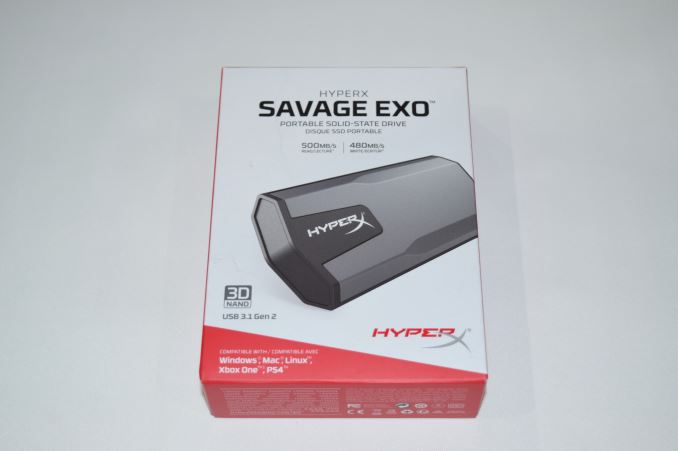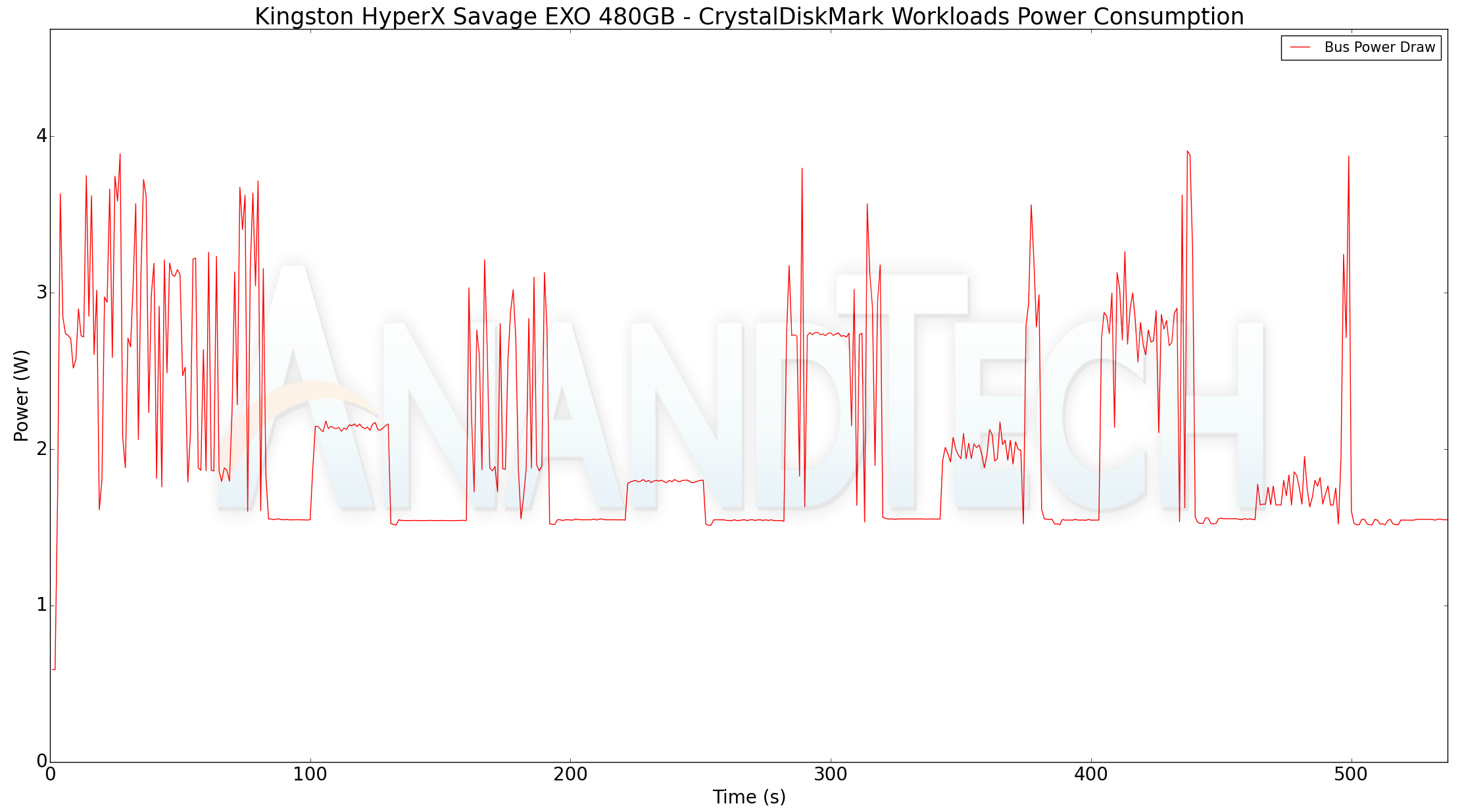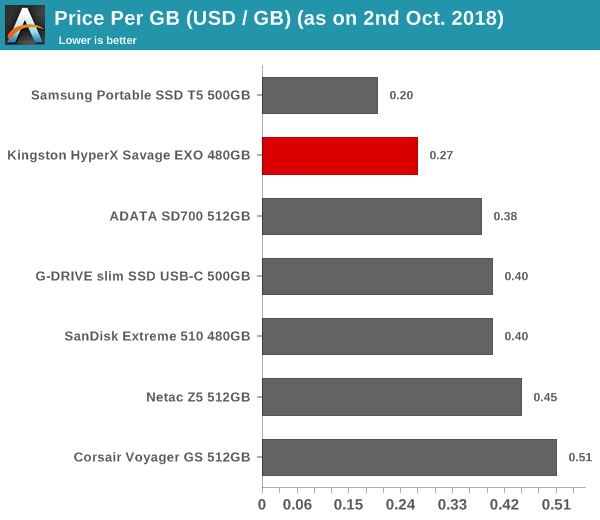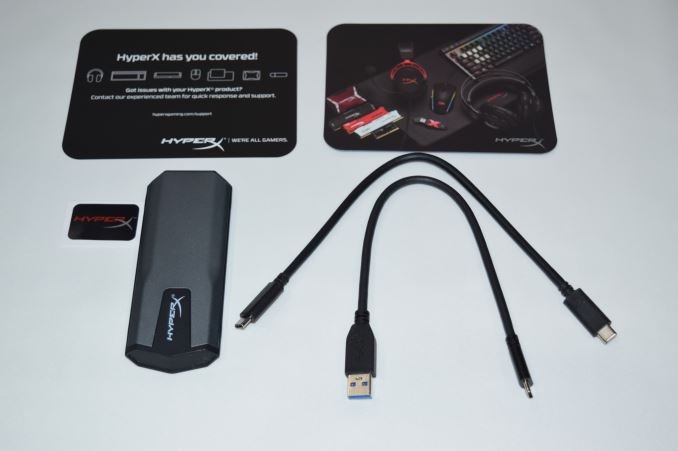
Original Link: https://www.anandtech.com/show/13412/kingston-hyperx-savage-exo-external-ssd-capsule-review
Kingston HyperX Savage EXO External SSD Capsule Review
by Ganesh T S on October 2, 2018 4:00 PM EST
The advent of 3D TLC flash has enabled a large number of budget-friendly bus-powered solid-state storage devices. On the external front, these devices fall under three major categories:
- Thumb drives: These usually come with USB 2.0 or USB 3.0 interfaces, and are meant to plug in directly into the host port without an extra cable. Capacities have been steadily increasing, though very few high-end models boast of peak performance in the 300 - 400 MBps range. Most low-end and mid-range thumb drives have write speeds of the order of 20 - 80 MBps, and read speeds of the order of 100 - 150 MBps.
- External SSDs (USB interface): Over the last few years, we have had vendors place a 2.5" SSD board behind a SATA - USB 3.0 bridge. These have now evolved into M.2 SATA SSDs behind a much smaller and more power-efficient SATA - USB 3.1 Gen 2 Type-C bridge. Such external SSDs now make up the bulk of the mid-range and high-end bus-powered external direct-attached storage devices.
- External SSDs (Thunderbolt 3 interface): Consumers requiring very bus-powered external storage with very high performance are served by Thunderbolt 3 SSDs that are surprisingly affordable despite their performance profile. These SSDs put a M.2 PCIe NVMe SSD behind a Thunderbolt 3 controller and deliver performance equivalent to an internal PCIe 3.0 x4 M.2 NVMe drive.
Kingston's HyperX Savage EXO SSD falls into the second category. It puts a M.2 2280 SATA SSD behind a SATA-to-USB 3.1 Gen 2 Type-C board and encloses them in a stylish case to target gamers. Kingston claims speeds of up to 500 MBps reads / 480 MBps writes, and a 20% reduction in game load times when used with leading game consoles. Does the product deliver on its claims, and more importantly, how does it fare against alternatives in the market?
Introduction
Kingston is no stranger to the external flash storage market, and its HyperX brand has produced some of the best-performing thumb drives using a flash controller with a direct USB interface. Kingston has also been a trusted vendor in the internal SSD space. It is surprising that we haven't had an external SSD from Kingston prior to the launch of the HyperX Savage EXO.
The HyperX Savage EXO is a 124mm x 49mm x 10mm device weighing 56g. The form-factor points to the use of a M.2 2280 SSD inside. It has a Type-C interface, and Kingston bundles two 12 in. USB cables (1x Type-C to Type-C, and, 1x Type-A to Type-C) along with the device. The drive comes pre-formatted in exFAT, allowing it to be used out-of-the-box with Windows PCs, Macs, and various game consoles.
Prior to looking at the internals, CrystalDiskInfo provides some insights.
| Drive Power Consumption - CrystalDiskMark Workloads |
 |
We see that the SSD idles around the 1.8W mark, and the peak power consumption (under heavy sequential write workloads) is just short of 4W.
The Kingston HyperX Savage EXO SSD supports TRIM under Windows as long as the volume is formatted in NTFS.
Moving on to the pricing aspect, the drive was launched at $220 on September 23rd, 2018. It is available on Amazon right now for $128. Of all the SSDs that we have evaluated in its capacity class, only the Portable SSD T5 from Samsung at $100 has a lower price per GB. Samsung's pricing is hard to beat due to the vertically integrated nature of its SSD business. We have not directly evaluated the SanDisk Extreme Portable SSD's 500GB version, but, its 1TB version impressed us a lot. The SanDisk Extreme Portable SSD 500 GB is priced at $110.

Even at $128, we believe that the Kingston HyperX Savage EXO a hard sell. To its credit, the device is currently Kingston's fastest bus-powered external storage device. The performance, as we see in the graphs above, is better than the external SSDs from various vendors released in the 2015 - 2017 timeframe. The hardware inside the Savage EXO is certainly powerful (it is essentially the same Marvell 88SS1074 controller, Toshiba / SanDisk BiCS 64L 3D TLC flash, and the ASMedia ASM235CM SATA-USB bridge as the SanDisk Extreme Portable SSD). However, the firmware needs a major overhaul in order to better serve the needs of its target market.








